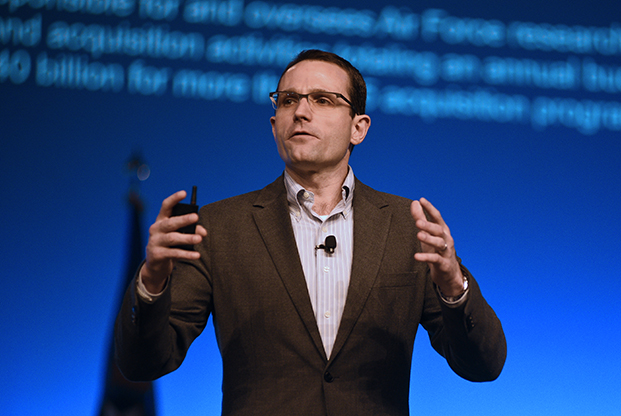Air Force acquisition czar Will Roper has been touting his new “Century Series” concept for building future fighter aircraft for nearly a year now, pressing the idea that by developing a series of shorter-lived aircraft programs that might share some common components and subassemblies, the Air Force can accelerate future aircraft development.
That’s the upside. So what can go wrong?
“Actually, there’s a lot that can go wrong,” he said at the Center for a New American Security Nov. 26. But in laying out the negatives, he also made clear what he sees as markers for success:
- Manage the fighter ecosystem. When the original Century Series played out in the 1950s, there were 13 firms building jet fighters in the United States. Today there are two. “At the macro level the biggest risk we have is that this has to be a closed ecosystem, similar to those like hydroponics, where everything has to be balanced,” Roper said. If it’s winner take all, in other words, the concept fails. “Similar to the original Century Series, I don’t think one, and only one airplane can be our future,” he said. “I don’t think we can bank on that.”
- Focus on design. “Design and innovation will always go hand in hand,” Roper said. Yet today’s business model in combat aviation rewards longevity over dynamic design: The more planes you build, the longer companies can rely on sustainment revenue supporting that product. That’s reminiscent of AT&T when the company was known as “Ma Bell” and once you installed a phone in your home it stayed there for the next 20 years. But phone design advanced little in those years. Roper is basing the new aircraft series on something closer to the iPhone model—new designs roll out on a predictable cycle as older models phase out. “We’ve got to have a business case that rewards design,” he says.
- Share components and subsystems. “We’ve got to make sure we ensure commonality, especially if we have more than one vendor building airplanes at the same time,” Roper said. “We need to be mindful that if we have multiple vendors, there have to be shared components. We can’t do sustainment with a mixed fleet. Those have to be ground rules for playing in the century series pipeline.”
- Volume of design, rather than volume manufactured, will drive innovation. “Similar to the 1950s, when air power was in flux with supersonic flight being possible by everyday pilots and faster and faster mach numbers and altitudes being achieved, we need to build, baby, build,” Roper said. Rapidly iterating designs, using innovations that work on one platform and then trying them out in concert with other changes in another, will shorten the learning curve, he said. Maintaining production rates of two or three planes a month won’t drive down production costs, but will make it possible to keep multiple production lines running at once for just a few years at a time.
- Don’t SLEP. Century Series airplanes should be built without any thought to future service life extension plans or heavy depot maintenance. Rather, by anticipating shorter service lives, so the airplanes can give way to successors gracefully. That approach could also lessen Congressional objections. “It’s hard to retire airplanes in this town,” Roper said, because such decisions have more recently not been accompanied by replacement aircraft. That would not be the case if new aircraft were already in the pipeline and flowing into service, “If you look at our business case to industry, 70 percent of what we offer companies in this business are sustainment opportunities.” That, he said, is like a hospital in an aging community, “where there’s a really big geriatric ward, and a very small pediatric ward—you’d really like that to be the other way around.”
He argues that a plane’s expiration date is every bit as essential as IOC. “We need to start caring about the expiration date. It’s just as important to make this ecosystem closed. - Change the industry. Roper’s dream is that a new era of competition and innovation in combat aviation could eventually draw one or more new entrants to the industry with radical new solutions, much as Tesla has proven it can be competitive building consumer automobiles and Blue Origin and SpaceX successfully disrupted the satellite launch industry.
“The idea that we could re-energize the design apparatus of our large [defense] companies has an appeal that’s just bigger than the dollars and cents,” Roper said.
Where this could lead, Roper suggested, is a future where, “We can separate design and production.” His hope then would be that advanced engineering could deliver future production lines “where multiple planes are being built on the same line,” and there is an industry that sees this new business model as “ beneficial to everyone in defense.”

3 thoughts on “Roper’s Six Keys to Century Series Success”
Comments are closed.